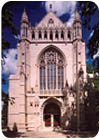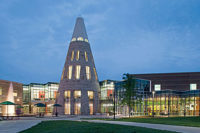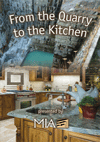
Due to decades of exposure to outdoor elements, the exterior of the Princeton University Chapel faced extensive deterioration, fracturing and loss of stonework, requiring an in-depth renovation and restoration designed by Farewell Mills Gatsch Architects LLC of Princeton, NJ. The project was completed in two separate year-long sections, with the second year focusing on the west facade pictured here. The successful completion of the project earned a 2004 Tucker Award from the Building Stone Institute.

Roaring Run Pennsylvania sandstone was used to restore decorative trim, gothic pinnacles, some infills and to patch existing sandstone. The material was quarried by Russell Stone Products of Curwensville, PA, and supplied through Delaware Quarries Inc. of Lumberville, PA.
While working on another project, Farewell Mills Gatsch Architects LLC discovered complications involving freestanding limestone pinnacles that were secured with Ferris pins. Since similar pinnacles were present at the Princeton University Chapel, the architects decided to survey the chapel to see if the same unsafe conditions applied. And, this was indeed the case, according to Katherine Frey, an architect with the firm. “A number of the pinnacles had been cracked, and a bunch of them were too short,†she said. “Based on that, we repined them with stainless steel and replaced the damaged units with Indiana limestone that matched the original stone.†Over 60 new units were carved to match the original pinnacles, using a combination of computerized lathes and hand carving.
As a result of the firm's findings, the two-year project began. They spent the first year of the restoration concentrating on the south and east facade, and the second year focusing on the north and west.
The exterior of the chapel is comprised of Pennsylvania sandstone in a random ashlar pattern. The material, which is referred to as “Roaring Run†sandstone, was quarried by Russell Stone Products of Curwensville, PA, and supplied through Delaware Quarries Inc. of Lumberville, PA. According to Farwell Mills Gatsch Architects LLC, the stone was handpicked to match the range of colors found at the chapel and tooled on site to match the existing stonework. The material was used to restore decorative trim, gothic pinnacles, some infills and to patch existing sandstone.
In addition to sandstone, Indiana limestone, carved by Old World Stone Ltd. of Toronto, Canada, was used as trim on the building, for more than 60 freestanding carved limestone pinnacles that line its facade, and for the chapel's sculptural door heads and borders. The same material was used to replace damaged units that had been patched with Dutchmen or other materials with new decorative pieces, according to Frey. “The supplier got the stone from Indiana, carved it in Canada and shipped it to the jobsite,†she said. “Over the period of carving, the design team went to Canada to review the models and shop drawings to make sure they resembled the original pieces.â€
In cases where the original stone details could be improved rather than completely replaced, a number of protective steps were taken. Wash surfaces were added, the number of vulnerable joints created through creative design and carving were reduced, and the thickness of units where pins were prone to corrosion because of water infiltration were increased.
On site, stone craftsmen carved limestone Dutchmen to replace “losses in engaged stone which were decorative, vulnerable to water infiltration or in an overhanging location,†according to the architects.
Frey said that the project's demanding schedule posed minor challenges for the crew, as a stained glass restoration was occurring simultaneously at the chapel. “The stained glass is set in the limestone, so the removal and reinstallation of the stained glass pieces and the coordination with the stonemason were challenging,†said Frey.
Technical advancements played a significant role in the restoration as well. The project team created computerized drawings from the originals, allowing them to examine a “stone-by-stone delineation of the limestone trim,†according to the architects. They also maintained a database that included every freestanding unit of limestone and every repair method to arrive at a schedule of quantities.
According to Project Manager/Vice President Jeff Frake of the Masonry Preservation Group, the limestone and ornamental limestone were severely eroded and soiled when they arrived on site. “It required in-situ carving and replacement,†he said. “The ashlar masonry was soiled and needed 100% repointing.â€
Frake said that an aggressive schedule, site logistics and the restoration and replication of existing stone posed problems for the 30 workers who were involved with the restoration.
“The project required an immediate start and the scaffolding had to be designed/engineered. MPG engineers and Princeton University engineers had to work long hours to achieve this,†he said, adding that the chapel had to remain in operation for all events, including services, concerts and weddings. “Interior scaffolding and protections had to be designed and installed so that the public would not be affected in anyway in terms of access or view of the event. This was achieved by working closely with the client and understanding their needs.â€
Frake also said that the restoration and replication of existing stone involved intricate in-situ carvings of limestone ornamentation, which was achieved by master stone carvers. Additionally, various masonry cleaning techniques had to be tested in order to project intricately carved limestone trim while tenacious dark staining was removed from the sandstone ashlar.

